Coursework Report: Analysis of Samsung's Organizational Structure
VerifiedAdded on 2022/02/04
|7
|1350
|110
Report
AI Summary
This report provides a comprehensive analysis of Samsung Electronics' organizational structure, specifically focusing on its divisional structure. The report begins with an introduction to Samsung, including its background and market position, followed by an in-depth examination of its divisional structure. Key elements of the structure, such as wider span of control, decentralization, and informal aspects, are discussed. The report then critically evaluates the advantages and disadvantages of Samsung's chosen structure, highlighting how it facilitates independent operation and communication between divisions while also addressing potential drawbacks such as increased costs and communication challenges. The conclusion emphasizes the structure's role in Samsung's success and offers recommendations for improvement, especially regarding inter-divisional communication. The report uses diagrams and references to support its analysis, offering a well-rounded perspective on the company's organizational framework.

Coursework
Report
Due: 21/02/2020
1005SSL: Organising For
Business
Student ID: 9426078
Report
Due: 21/02/2020
1005SSL: Organising For
Business
Student ID: 9426078
Paraphrase This Document
Need a fresh take? Get an instant paraphrase of this document with our AI Paraphraser
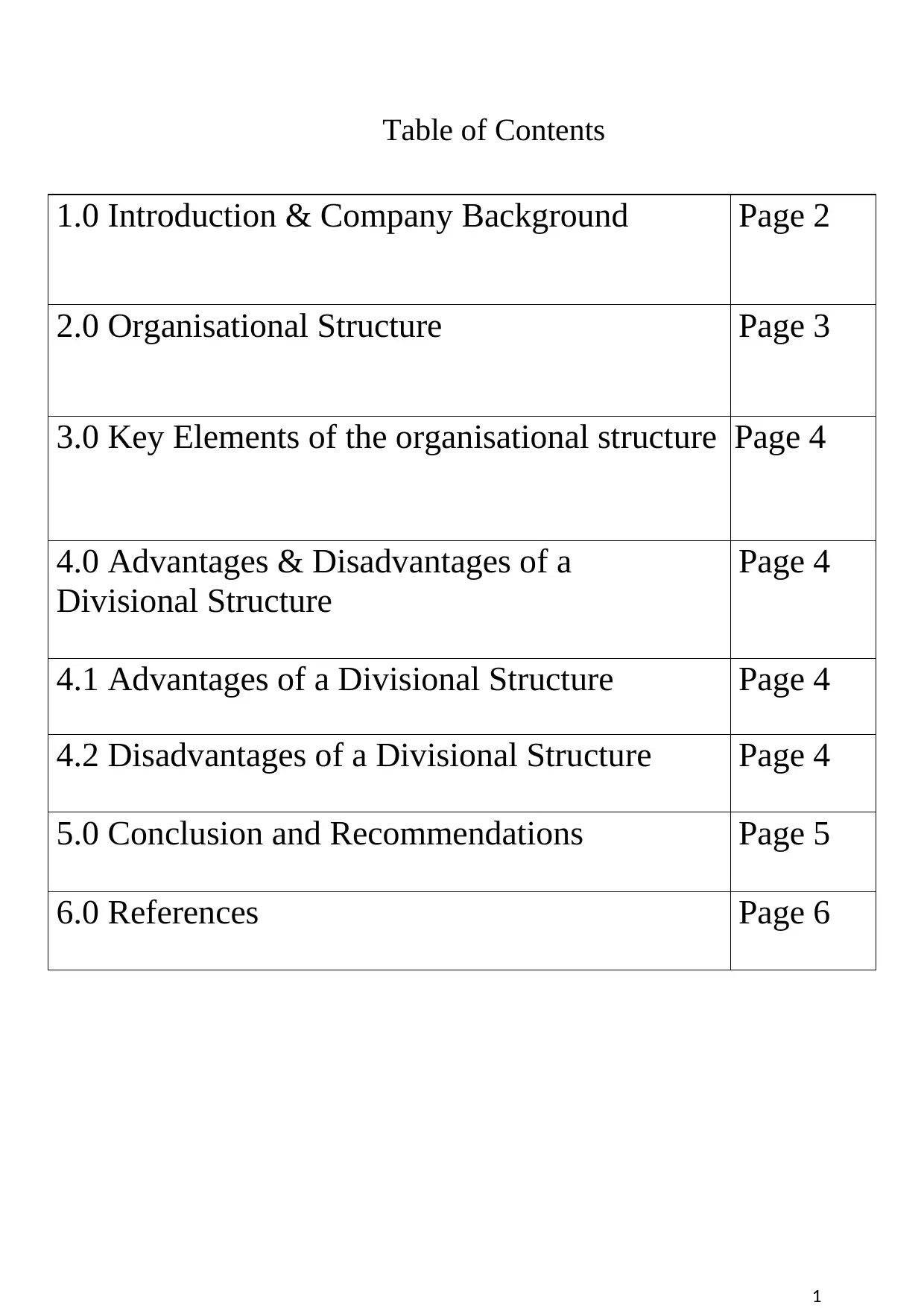
1
Table of Contents
1.0 Introduction & Company Background Page 2
2.0 Organisational Structure Page 3
3.0 Key Elements of the organisational structure Page 4
4.0 Advantages & Disadvantages of a
Divisional Structure
Page 4
4.1 Advantages of a Divisional Structure Page 4
4.2 Disadvantages of a Divisional Structure Page 4
5.0 Conclusion and Recommendations Page 5
6.0 References Page 6
Table of Contents
1.0 Introduction & Company Background Page 2
2.0 Organisational Structure Page 3
3.0 Key Elements of the organisational structure Page 4
4.0 Advantages & Disadvantages of a
Divisional Structure
Page 4
4.1 Advantages of a Divisional Structure Page 4
4.2 Disadvantages of a Divisional Structure Page 4
5.0 Conclusion and Recommendations Page 5
6.0 References Page 6
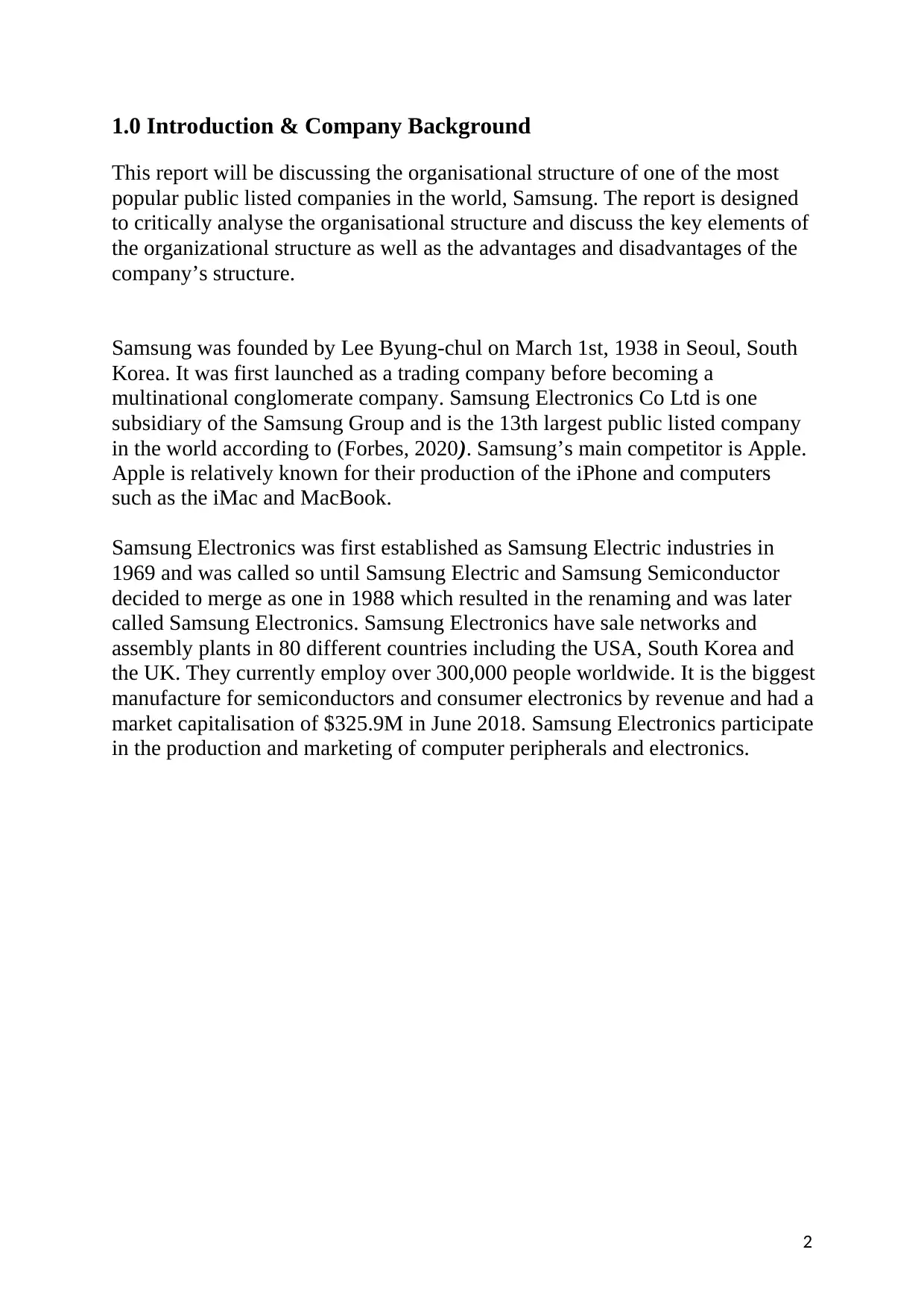
2
1.0 Introduction & Company Background
This report will be discussing the organisational structure of one of the most
popular public listed companies in the world, Samsung. The report is designed
to critically analyse the organisational structure and discuss the key elements of
the organizational structure as well as the advantages and disadvantages of the
company’s structure.
Samsung was founded by Lee Byung-chul on March 1st, 1938 in Seoul, South
Korea. It was first launched as a trading company before becoming a
multinational conglomerate company. Samsung Electronics Co Ltd is one
subsidiary of the Samsung Group and is the 13th largest public listed company
in the world according to (Forbes, 2020). Samsung’s main competitor is Apple.
Apple is relatively known for their production of the iPhone and computers
such as the iMac and MacBook.
Samsung Electronics was first established as Samsung Electric industries in
1969 and was called so until Samsung Electric and Samsung Semiconductor
decided to merge as one in 1988 which resulted in the renaming and was later
called Samsung Electronics. Samsung Electronics have sale networks and
assembly plants in 80 different countries including the USA, South Korea and
the UK. They currently employ over 300,000 people worldwide. It is the biggest
manufacture for semiconductors and consumer electronics by revenue and had a
market capitalisation of $325.9M in June 2018. Samsung Electronics participate
in the production and marketing of computer peripherals and electronics.
1.0 Introduction & Company Background
This report will be discussing the organisational structure of one of the most
popular public listed companies in the world, Samsung. The report is designed
to critically analyse the organisational structure and discuss the key elements of
the organizational structure as well as the advantages and disadvantages of the
company’s structure.
Samsung was founded by Lee Byung-chul on March 1st, 1938 in Seoul, South
Korea. It was first launched as a trading company before becoming a
multinational conglomerate company. Samsung Electronics Co Ltd is one
subsidiary of the Samsung Group and is the 13th largest public listed company
in the world according to (Forbes, 2020). Samsung’s main competitor is Apple.
Apple is relatively known for their production of the iPhone and computers
such as the iMac and MacBook.
Samsung Electronics was first established as Samsung Electric industries in
1969 and was called so until Samsung Electric and Samsung Semiconductor
decided to merge as one in 1988 which resulted in the renaming and was later
called Samsung Electronics. Samsung Electronics have sale networks and
assembly plants in 80 different countries including the USA, South Korea and
the UK. They currently employ over 300,000 people worldwide. It is the biggest
manufacture for semiconductors and consumer electronics by revenue and had a
market capitalisation of $325.9M in June 2018. Samsung Electronics participate
in the production and marketing of computer peripherals and electronics.
⊘ This is a preview!⊘
Do you want full access?
Subscribe today to unlock all pages.

Trusted by 1+ million students worldwide
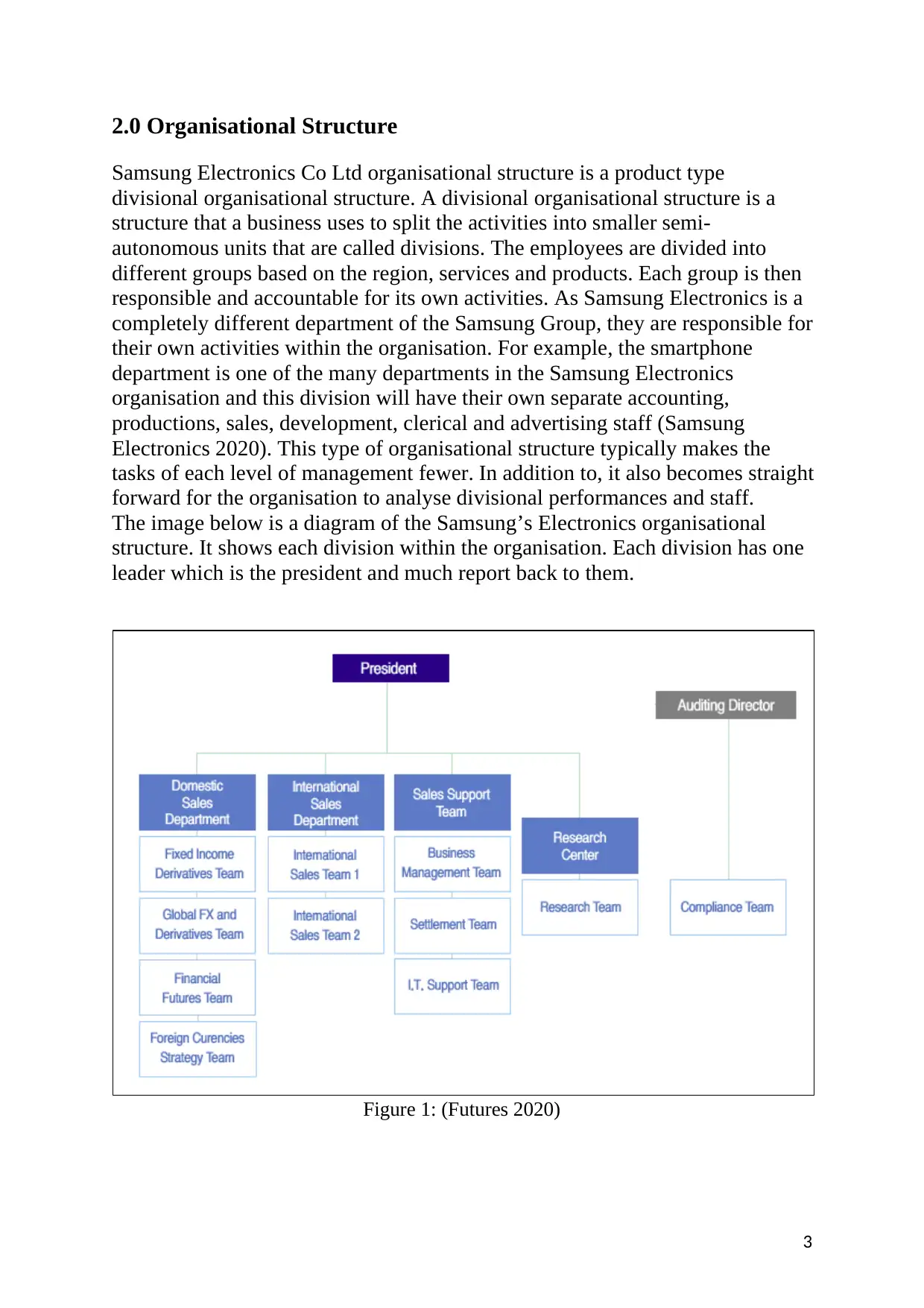
3
2.0 Organisational Structure
Samsung Electronics Co Ltd organisational structure is a product type
divisional organisational structure. A divisional organisational structure is a
structure that a business uses to split the activities into smaller semi-
autonomous units that are called divisions. The employees are divided into
different groups based on the region, services and products. Each group is then
responsible and accountable for its own activities. As Samsung Electronics is a
completely different department of the Samsung Group, they are responsible for
their own activities within the organisation. For example, the smartphone
department is one of the many departments in the Samsung Electronics
organisation and this division will have their own separate accounting,
productions, sales, development, clerical and advertising staff (Samsung
Electronics 2020). This type of organisational structure typically makes the
tasks of each level of management fewer. In addition to, it also becomes straight
forward for the organisation to analyse divisional performances and staff.
The image below is a diagram of the Samsung’s Electronics organisational
structure. It shows each division within the organisation. Each division has one
leader which is the president and much report back to them.
Figure 1: (Futures 2020)
2.0 Organisational Structure
Samsung Electronics Co Ltd organisational structure is a product type
divisional organisational structure. A divisional organisational structure is a
structure that a business uses to split the activities into smaller semi-
autonomous units that are called divisions. The employees are divided into
different groups based on the region, services and products. Each group is then
responsible and accountable for its own activities. As Samsung Electronics is a
completely different department of the Samsung Group, they are responsible for
their own activities within the organisation. For example, the smartphone
department is one of the many departments in the Samsung Electronics
organisation and this division will have their own separate accounting,
productions, sales, development, clerical and advertising staff (Samsung
Electronics 2020). This type of organisational structure typically makes the
tasks of each level of management fewer. In addition to, it also becomes straight
forward for the organisation to analyse divisional performances and staff.
The image below is a diagram of the Samsung’s Electronics organisational
structure. It shows each division within the organisation. Each division has one
leader which is the president and much report back to them.
Figure 1: (Futures 2020)
Paraphrase This Document
Need a fresh take? Get an instant paraphrase of this document with our AI Paraphraser
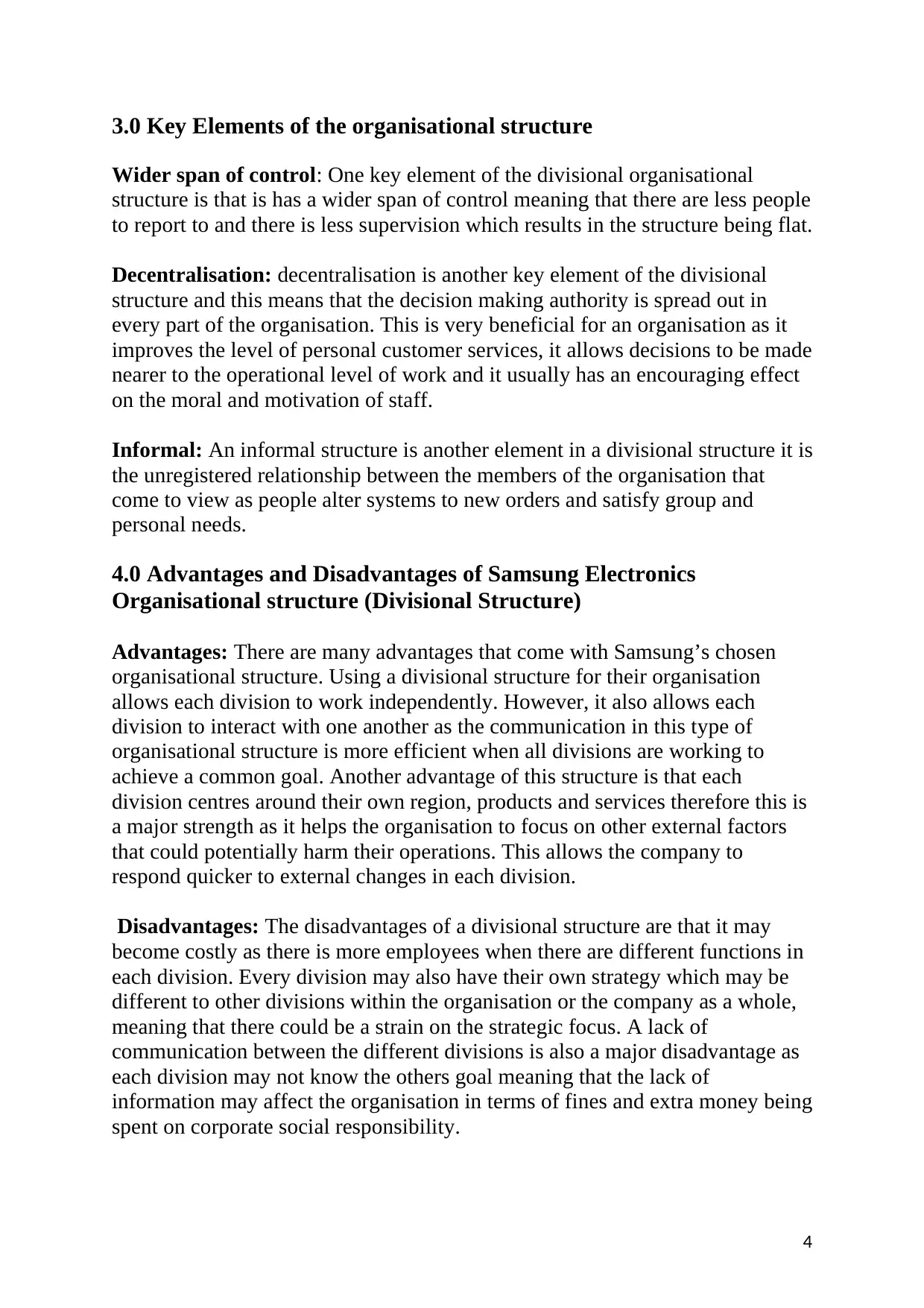
4
3.0 Key Elements of the organisational structure
Wider span of control: One key element of the divisional organisational
structure is that is has a wider span of control meaning that there are less people
to report to and there is less supervision which results in the structure being flat.
Decentralisation: decentralisation is another key element of the divisional
structure and this means that the decision making authority is spread out in
every part of the organisation. This is very beneficial for an organisation as it
improves the level of personal customer services, it allows decisions to be made
nearer to the operational level of work and it usually has an encouraging effect
on the moral and motivation of staff.
Informal: An informal structure is another element in a divisional structure it is
the unregistered relationship between the members of the organisation that
come to view as people alter systems to new orders and satisfy group and
personal needs.
4.0 Advantages and Disadvantages of Samsung Electronics
Organisational structure (Divisional Structure)
Advantages: There are many advantages that come with Samsung’s chosen
organisational structure. Using a divisional structure for their organisation
allows each division to work independently. However, it also allows each
division to interact with one another as the communication in this type of
organisational structure is more efficient when all divisions are working to
achieve a common goal. Another advantage of this structure is that each
division centres around their own region, products and services therefore this is
a major strength as it helps the organisation to focus on other external factors
that could potentially harm their operations. This allows the company to
respond quicker to external changes in each division.
Disadvantages: The disadvantages of a divisional structure are that it may
become costly as there is more employees when there are different functions in
each division. Every division may also have their own strategy which may be
different to other divisions within the organisation or the company as a whole,
meaning that there could be a strain on the strategic focus. A lack of
communication between the different divisions is also a major disadvantage as
each division may not know the others goal meaning that the lack of
information may affect the organisation in terms of fines and extra money being
spent on corporate social responsibility.
3.0 Key Elements of the organisational structure
Wider span of control: One key element of the divisional organisational
structure is that is has a wider span of control meaning that there are less people
to report to and there is less supervision which results in the structure being flat.
Decentralisation: decentralisation is another key element of the divisional
structure and this means that the decision making authority is spread out in
every part of the organisation. This is very beneficial for an organisation as it
improves the level of personal customer services, it allows decisions to be made
nearer to the operational level of work and it usually has an encouraging effect
on the moral and motivation of staff.
Informal: An informal structure is another element in a divisional structure it is
the unregistered relationship between the members of the organisation that
come to view as people alter systems to new orders and satisfy group and
personal needs.
4.0 Advantages and Disadvantages of Samsung Electronics
Organisational structure (Divisional Structure)
Advantages: There are many advantages that come with Samsung’s chosen
organisational structure. Using a divisional structure for their organisation
allows each division to work independently. However, it also allows each
division to interact with one another as the communication in this type of
organisational structure is more efficient when all divisions are working to
achieve a common goal. Another advantage of this structure is that each
division centres around their own region, products and services therefore this is
a major strength as it helps the organisation to focus on other external factors
that could potentially harm their operations. This allows the company to
respond quicker to external changes in each division.
Disadvantages: The disadvantages of a divisional structure are that it may
become costly as there is more employees when there are different functions in
each division. Every division may also have their own strategy which may be
different to other divisions within the organisation or the company as a whole,
meaning that there could be a strain on the strategic focus. A lack of
communication between the different divisions is also a major disadvantage as
each division may not know the others goal meaning that the lack of
information may affect the organisation in terms of fines and extra money being
spent on corporate social responsibility.
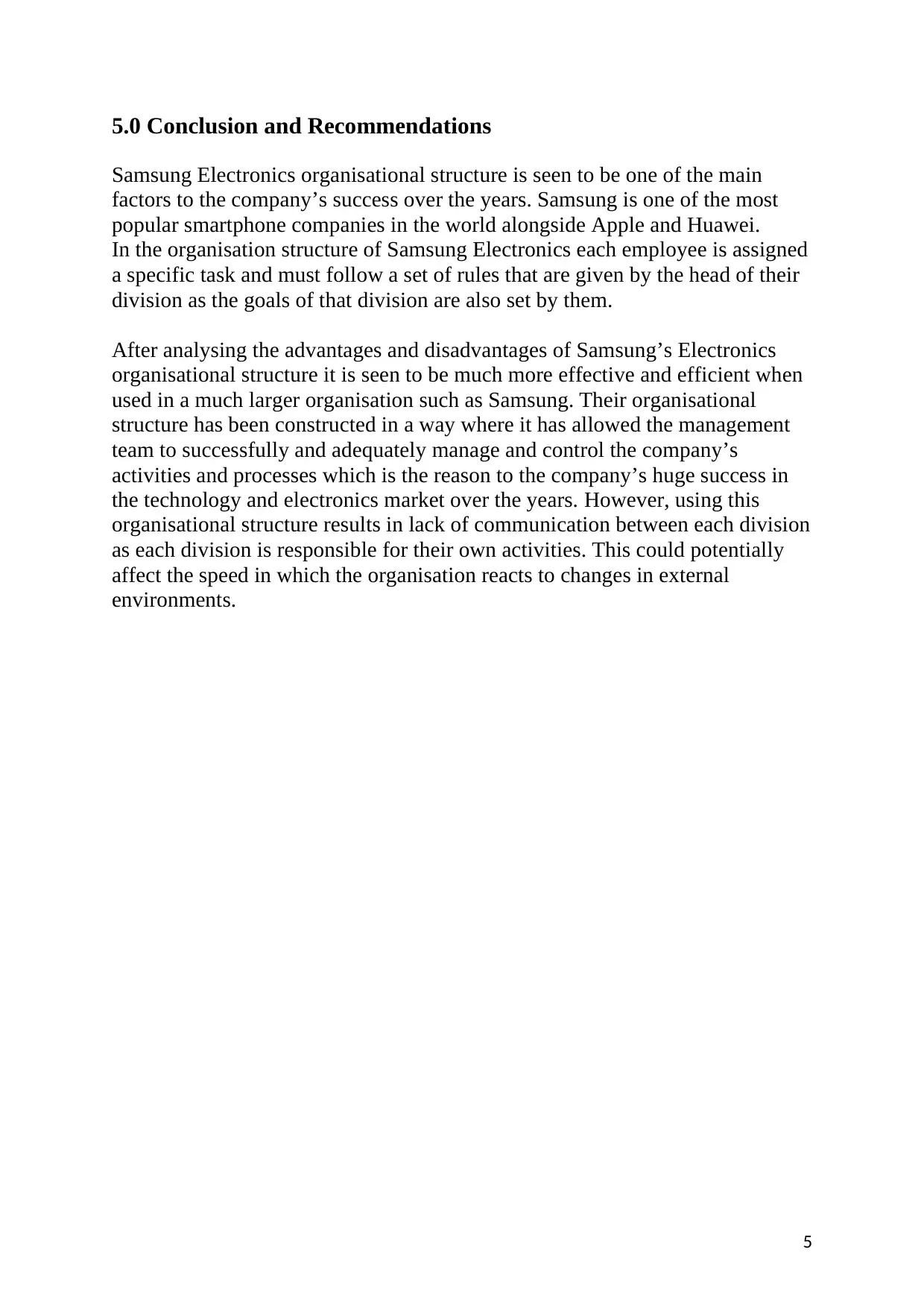
5
5.0 Conclusion and Recommendations
Samsung Electronics organisational structure is seen to be one of the main
factors to the company’s success over the years. Samsung is one of the most
popular smartphone companies in the world alongside Apple and Huawei.
In the organisation structure of Samsung Electronics each employee is assigned
a specific task and must follow a set of rules that are given by the head of their
division as the goals of that division are also set by them.
After analysing the advantages and disadvantages of Samsung’s Electronics
organisational structure it is seen to be much more effective and efficient when
used in a much larger organisation such as Samsung. Their organisational
structure has been constructed in a way where it has allowed the management
team to successfully and adequately manage and control the company’s
activities and processes which is the reason to the company’s huge success in
the technology and electronics market over the years. However, using this
organisational structure results in lack of communication between each division
as each division is responsible for their own activities. This could potentially
affect the speed in which the organisation reacts to changes in external
environments.
5.0 Conclusion and Recommendations
Samsung Electronics organisational structure is seen to be one of the main
factors to the company’s success over the years. Samsung is one of the most
popular smartphone companies in the world alongside Apple and Huawei.
In the organisation structure of Samsung Electronics each employee is assigned
a specific task and must follow a set of rules that are given by the head of their
division as the goals of that division are also set by them.
After analysing the advantages and disadvantages of Samsung’s Electronics
organisational structure it is seen to be much more effective and efficient when
used in a much larger organisation such as Samsung. Their organisational
structure has been constructed in a way where it has allowed the management
team to successfully and adequately manage and control the company’s
activities and processes which is the reason to the company’s huge success in
the technology and electronics market over the years. However, using this
organisational structure results in lack of communication between each division
as each division is responsible for their own activities. This could potentially
affect the speed in which the organisation reacts to changes in external
environments.
⊘ This is a preview!⊘
Do you want full access?
Subscribe today to unlock all pages.

Trusted by 1+ million students worldwide
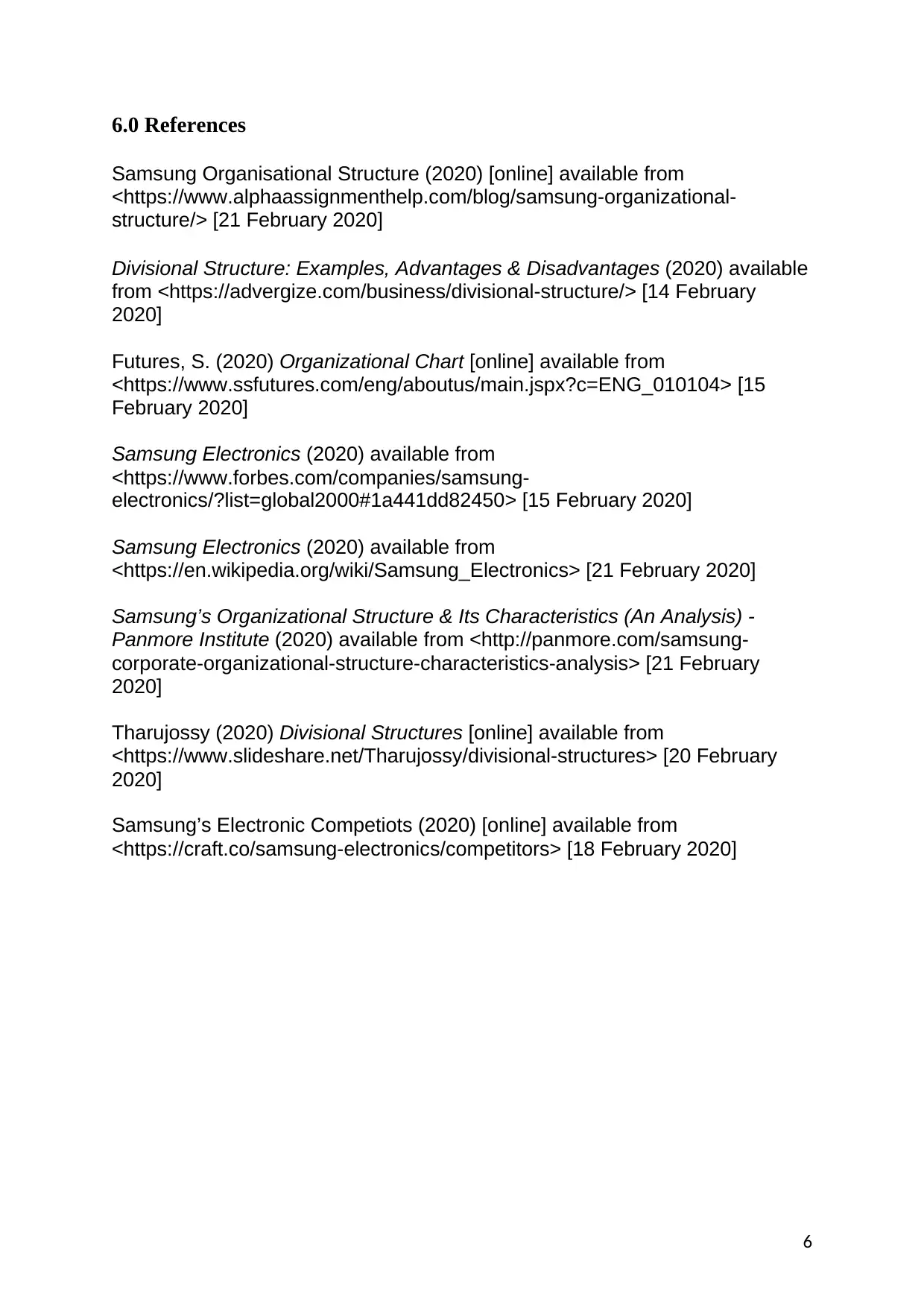
6
6.0 References
Samsung Organisational Structure (2020) [online] available from
<https://www.alphaassignmenthelp.com/blog/samsung-organizational-
structure/> [21 February 2020]
Divisional Structure: Examples, Advantages & Disadvantages (2020) available
from <https://advergize.com/business/divisional-structure/> [14 February
2020]
Futures, S. (2020) Organizational Chart [online] available from
<https://www.ssfutures.com/eng/aboutus/main.jspx?c=ENG_010104> [15
February 2020]
Samsung Electronics (2020) available from
<https://www.forbes.com/companies/samsung-
electronics/?list=global2000#1a441dd82450> [15 February 2020]
Samsung Electronics (2020) available from
<https://en.wikipedia.org/wiki/Samsung_Electronics> [21 February 2020]
Samsung’s Organizational Structure & Its Characteristics (An Analysis) -
Panmore Institute (2020) available from <http://panmore.com/samsung-
corporate-organizational-structure-characteristics-analysis> [21 February
2020]
Tharujossy (2020) Divisional Structures [online] available from
<https://www.slideshare.net/Tharujossy/divisional-structures> [20 February
2020]
Samsung’s Electronic Competiots (2020) [online] available from
<https://craft.co/samsung-electronics/competitors> [18 February 2020]
6.0 References
Samsung Organisational Structure (2020) [online] available from
<https://www.alphaassignmenthelp.com/blog/samsung-organizational-
structure/> [21 February 2020]
Divisional Structure: Examples, Advantages & Disadvantages (2020) available
from <https://advergize.com/business/divisional-structure/> [14 February
2020]
Futures, S. (2020) Organizational Chart [online] available from
<https://www.ssfutures.com/eng/aboutus/main.jspx?c=ENG_010104> [15
February 2020]
Samsung Electronics (2020) available from
<https://www.forbes.com/companies/samsung-
electronics/?list=global2000#1a441dd82450> [15 February 2020]
Samsung Electronics (2020) available from
<https://en.wikipedia.org/wiki/Samsung_Electronics> [21 February 2020]
Samsung’s Organizational Structure & Its Characteristics (An Analysis) -
Panmore Institute (2020) available from <http://panmore.com/samsung-
corporate-organizational-structure-characteristics-analysis> [21 February
2020]
Tharujossy (2020) Divisional Structures [online] available from
<https://www.slideshare.net/Tharujossy/divisional-structures> [20 February
2020]
Samsung’s Electronic Competiots (2020) [online] available from
<https://craft.co/samsung-electronics/competitors> [18 February 2020]
1 out of 7
Related Documents
Your All-in-One AI-Powered Toolkit for Academic Success.
+13062052269
info@desklib.com
Available 24*7 on WhatsApp / Email
![[object Object]](/_next/static/media/star-bottom.7253800d.svg)
Unlock your academic potential
Copyright © 2020–2025 A2Z Services. All Rights Reserved. Developed and managed by ZUCOL.





